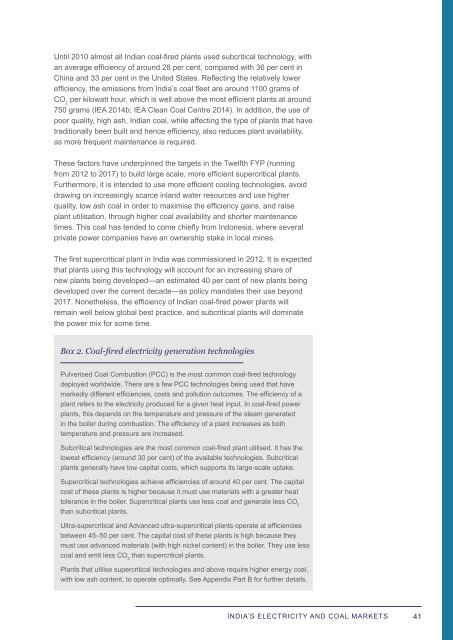Coal in India
1P05mmm
1P05mmm
You also want an ePaper? Increase the reach of your titles
YUMPU automatically turns print PDFs into web optimized ePapers that Google loves.
Until 2010 almost all <strong>India</strong>n coal-fired plants used subcritical technology, withan average efficiency of around 28 per cent, compared with 36 per cent <strong>in</strong>Ch<strong>in</strong>a and 33 per cent <strong>in</strong> the United States. Reflect<strong>in</strong>g the relatively lowerefficiency, the emissions from <strong>India</strong>’s coal fleet are around 1100 grams ofCO 2per kilowatt hour, which is well above the most efficient plants at around750 grams (IEA 2014b; IEA Clean <strong>Coal</strong> Centre 2014). In addition, the use ofpoor quality, high ash, <strong>India</strong>n coal, while affect<strong>in</strong>g the type of plants that havetraditionally been built and hence efficiency, also reduces plant availability,as more frequent ma<strong>in</strong>tenance is required.These factors have underp<strong>in</strong>ned the targets <strong>in</strong> the Twelfth FYP (runn<strong>in</strong>gfrom 2012 to 2017) to build large scale, more efficient supercritical plants.Furthermore, it is <strong>in</strong>tended to use more efficient cool<strong>in</strong>g technologies, avoiddraw<strong>in</strong>g on <strong>in</strong>creas<strong>in</strong>gly scarce <strong>in</strong>land water resources and use higherquality, low ash coal <strong>in</strong> order to maximise the efficiency ga<strong>in</strong>s, and raiseplant utilisation, through higher coal availability and shorter ma<strong>in</strong>tenancetimes. This coal has tended to come chiefly from Indonesia, where severalprivate power companies have an ownership stake <strong>in</strong> local m<strong>in</strong>es.The first supercritical plant <strong>in</strong> <strong>India</strong> was commissioned <strong>in</strong> 2012. It is expectedthat plants us<strong>in</strong>g this technology will account for an <strong>in</strong>creas<strong>in</strong>g share ofnew plants be<strong>in</strong>g developed—an estimated 40 per cent of new plants be<strong>in</strong>gdeveloped over the current decade—as policy mandates their use beyond2017. Nonetheless, the efficiency of <strong>India</strong>n coal-fired power plants willrema<strong>in</strong> well below global best practice, and subcritical plants will dom<strong>in</strong>atethe power mix for some time.Box 2. <strong>Coal</strong>-fired electricity generation technologiesPulverised <strong>Coal</strong> Combustion (PCC) is the most common coal-fired technologydeployed worldwide. There are a few PCC technologies be<strong>in</strong>g used that havemarkedly different efficiencies, costs and pollution outcomes. The efficiency of aplant refers to the electricity produced for a given heat <strong>in</strong>put. In coal-fired powerplants, this depends on the temperature and pressure of the steam generated<strong>in</strong> the boiler dur<strong>in</strong>g combustion. The efficiency of a plant <strong>in</strong>creases as bothtemperature and pressure are <strong>in</strong>creased.Subcritical technologies are the most common coal-fired plant utilised. It has thelowest efficiency (around 30 per cent) of the available technologies. Subcriticalplants generally have low capital costs, which supports its large-scale uptake.Supercritical technologies achieve efficiencies of around 40 per cent. The capitalcost of these plants is higher because it must use materials with a greater heattolerance <strong>in</strong> the boiler. Supercritical plants use less coal and generate less CO 2than subcritical plants.Ultra-supercritical and Advanced ultra-supercritical plants operate at efficienciesbetween 45–50 per cent. The capital cost of these plants is high because theymust use advanced materials (with high nickel content) <strong>in</strong> the boiler. They use lesscoal and emit less CO 2than supercritical plants.Plants that utilise supercritical technologies and above require higher energy coal,with low ash content, to operate optimally. See Appendix Part B for further details.INDIA’S ELECTRICITY AND COAL MARKETS41


